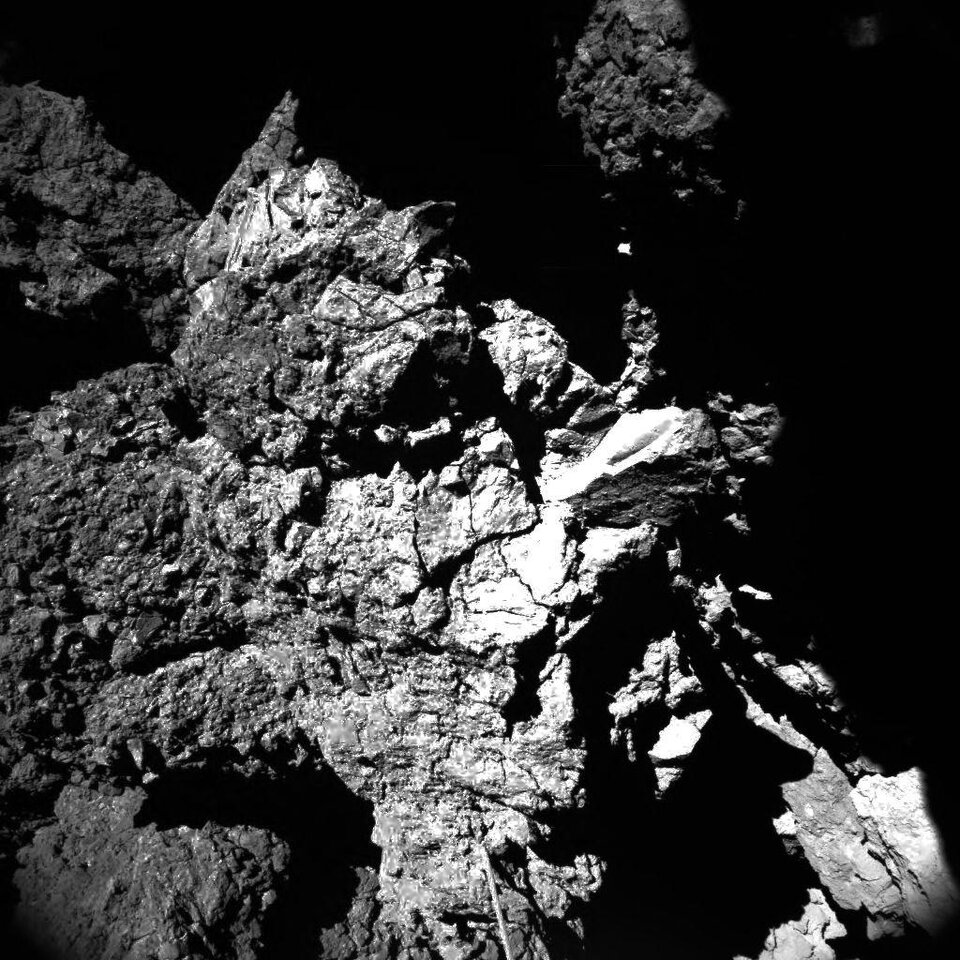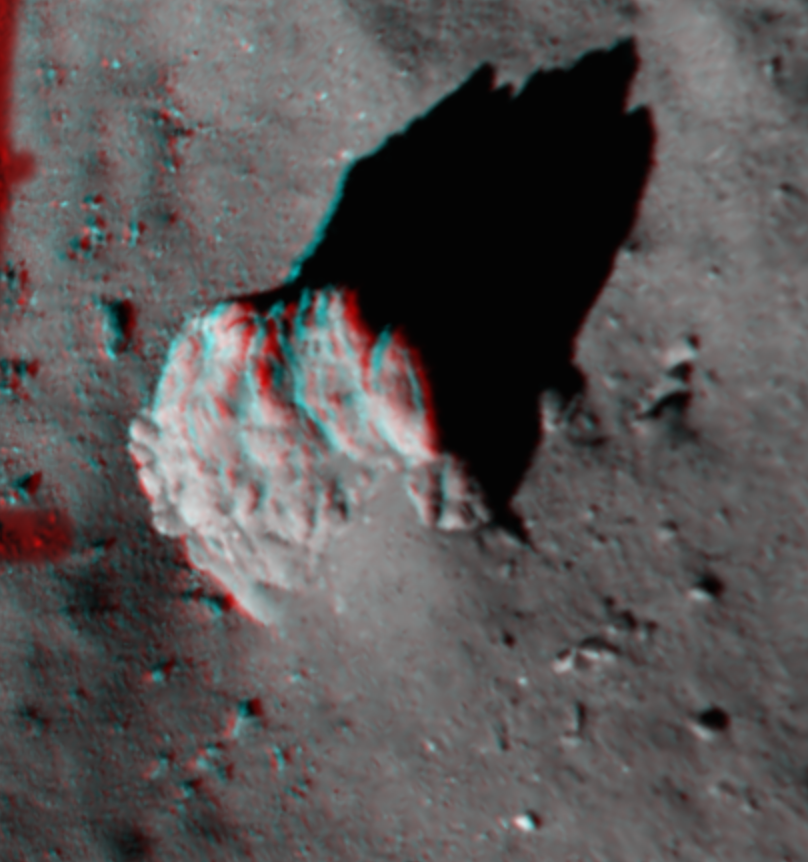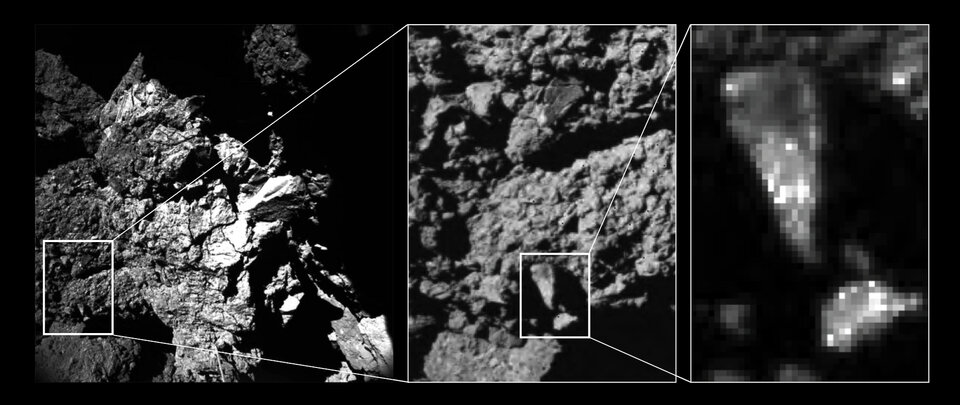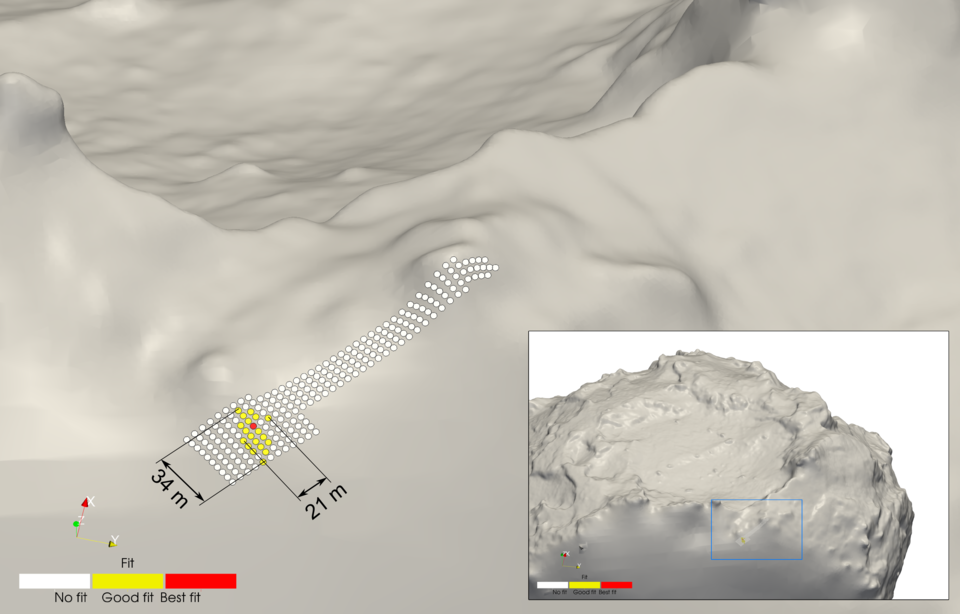Science on the surface of a comet (original) (raw)
Science & Exploration
30/07/2015 57322 views 224 likes
Complex molecules that could be key building blocks of life, the daily rise and fall of temperature, and an assessment of the surface properties and internal structure of the comet are just some of the highlights of the first scientific analysis of the data returned by Rosetta’s lander Philae last November.
Early results from Philae’s first suite of scientific observations of Comet 67P/Churyumov-Gerasimenko were published today in a special edition of the journal Science.
Data were obtained during the lander’s seven-hour descent to its first touchdown at the Agilkia landing site, which then triggered the start of a sequence of predefined experiments. But shortly after touchdown, it became apparent that Philae had rebounded and so a number of measurements were carried out as the lander took flight for an additional two hours some 100 m above the comet, before finally landing at Abydos.
Some 80% of the first science sequence was completed in the 64 hours following separation before Philae fell into hibernation, with the unexpected bonus that data were ultimately collected at more than one location, allowing comparisons between the touchdown sites.
Inflight science
After the first touchdown at Agilkia, the gas-sniffing instruments Ptolemy and COSAC analysed samples entering the lander and determined the chemical composition of the comet’s gas and dust, important tracers of the raw materials present in the early Solar System.
COSAC analysed samples entering tubes at the bottom of the lander kicked up during the first touchdown, dominated by the volatile ingredients of ice-poor dust grains. This revealed a suite of 16 organic compounds comprising numerous carbon and nitrogen-rich compounds, including four compounds – methyl isocyanate, acetone, propionaldehyde and acetamide – that have never before been detected in comets.
Meanwhile, Ptolemy sampled ambient gas entering tubes at the top of the lander and detected the main components of coma gases – water vapour, carbon monoxide and carbon dioxide, along with smaller amounts of carbon-bearing organic compounds, including formaldehyde.
Importantly, some of these compounds detected by Ptolemy and COSAC play a key role in the prebiotic synthesis of amino acids, sugars and nucleobases: the ingredients for life. For example, formaldehyde is implicated in the formation of ribose, which ultimately features in molecules like DNA.
The existence of such complex molecules in a comet, a relic of the early Solar System, imply that chemical processes at work during that time could have played a key role in fostering the formation of prebiotic material.
Continue reading below
Comparing touchdown sites
3D view of large boulder at Agilkia
Thanks to the images taken by ROLIS on the descent to Agilkia, and the CIVA images taken at Abydos, a visual comparison of the topography at these two locations could be made.
ROLIS images taken shortly before the first touchdown revealed a surface comprising metre-size blocks of diverse shapes, coarse regolith with grain sizes of 10–50 cm, and granules less than 10 cm across.
The regolith at Agilkia is thought to extend to a depth of 2 m in places, but seems to be free from fine-grained dust deposits at the resolution of the images.
The largest boulder in the ROLIS field-of-view measures about 5 m high, with a peculiar bumpy structure and fracture lines running through it that suggest erosional forces are working to fragment the comet’s boulders into smaller pieces.
The boulder also has a tapered ‘tail’ of debris behind it, similar to others seen in images taken by Rosetta from orbit, yielding clues as to how particles lifted up from one part of the eroding comet are deposited elsewhere.
Brightness variations of comet surface
Over a kilometre away at Abydos, not only did the images taken by CIVA’s seven microcameras reveal details in the surrounding terrain down to the millimetre scale, but also helped decipher Philae’s orientation.
The lander is angled up against a cliff face that is roughly 1 m from the open ‘balcony’ side of Philae, with stereo imagery showing further topography up to 7 m away, and one camera with open sky above.
The images reveal fractures in the comet’s cliff walls that are ubiquitous at all scales. Importantly, the material surrounding Philae is dominated by dark agglomerates, perhaps comprising organic-rich grains. Brighter spots likely represent differences in mineral composition, and may even point to ice-rich materials.
From the surface to the interior
The MUPUS suite of instruments provided insight into the physical properties of Abydos. Its penetrating ‘hammer’ showed the surface and subsurface material sampled to be substantially harder than that at Agilkia, as inferred from the mechanical analysis of the first landing.
The results point to a thin layer of dust less than 3 cm thick overlying a much harder compacted mixture of dust and ice at Abydos. At Agilkia, this harder layer may well exist at a greater depth than that encountered by Philae.
MUPUS investigations at Abydos
The MUPUS thermal sensor, on Philae’s balcony, revealed a variation in the local temperature between about –180ºC and –145ºC in sync with the comet’s 12.4 hour day. The thermal inertia implied by the measured rapid rise and fall in the temperature also indicates a thin layer of dust atop a compacted dust-ice crust.
Moving below the surface, unique information concerning the global interior structure of the comet was provided by CONSERT, which passed radio waves through the nucleus between the lander and the orbiter.
Philae best fit search ellipse
The results show that the small lobe of the comet is consistent with a very loosely compacted (porosity 75–85%) mixture of dust and ice (dust-to-ice ratio 0.4–2.6 by volume) that is fairly homogeneous on the scale of tens of metres.
In addition, CONSERT was used to help triangulate Philae’s location on the surface, with the best fit solution currently pointing to a 21 x 34 m area.
“Taken together, these first pioneering measurements performed on the surface of a comet are profoundly changing our view of these worlds and continuing to shape our impression of the history of the Solar System,” says Jean-Pierre Bibring, a lead lander scientist and principal investigator of the CIVA instrument at the IAS in Orsay, France.
“The reactivation would allow us to complete the characterisation of the elemental, isotopic and molecular composition of the cometary material, in particular of its refractory phases, by APXS, CIVA-M, Ptolemy and COSAC.”
“With Philae making contact again in mid-June, we still hope that it can be reactivated to continue this exciting adventure, with the chance for more scientific measurements and new images which could show us surface changes or shifts in Philae’s position since landing over eight months ago,” says DLR’s Lander Manager Stephan Ulamec.
“These ground-truth observations at a couple of locations anchor the extensive remote measurements performed by Rosetta covering the whole comet from above over the last year,” says Nicolas Altobelli, ESA’s acting Rosetta project scientist.
“With perihelion fast approaching, we are busy monitoring the comet’s activity from a safe distance and looking for any changes in the surface features, and we hope that Philae will be able to send us complementary reports from its location on the surface.”
Notes for editors
The 31 July 2015 Science special issue includes the following papers:
“The nonmagnetic nucleus of comet 67P/Churyumov–Gerasimenko,” by H.-U. Auster et al. (Covered in a previous press release: Rosetta and Philae find comet not magnetised)
“67P/Churyumov-Gerasimenko surface properties as derived from CIVA panoramic images,” by J-P. Bibring et al.
“The landing(s) of Philae and inferences about comet surface mechanical properties,” by J. Biele et al.
“Organic compounds on comet 67P/Churyumov-Gerasimenko revealed by COSAC mass spectrometry_,_”by F. Goesmann et al.
“Properties of the 67P/Churyumov–Gerasimenko interior revealed by CONSERT radar,” by W. Kofman et al.
“The structure of the regolith on 67P/ Churyumov–Gerasimenko from ROLIS descent imaging_,”_ by S. Mottola et al.
“Thermal and mechanical properties of the near-surface layers of comet 67P/Churyumov–Gerasimenko_,”_ by T. Spohn et al.
“CHO-bearing organic compounds at the surface of 67P/Churyumov–Gerasimenko revealed by Ptolemy,” by I.P. Wright et al.
Individual ROLIS and CIVA images are available via our "Landing on a comet" gallery.
About Rosetta
Rosetta is an ESA mission with contributions from its Member States and NASA. Rosetta’s Philae lander is contributed by a consortium led by DLR, MPS, CNES and ASI.
For further information, please contact:
Nicolas Altobelli
Acting Rosetta Project Scientist
Email: Nicolas.Altobelli@sciops.esa.int
Jean-Pierre Bibring
Lead lander scientist and principal investigator of CIVA
Institut d’Astrophysique Spatiale (IAS), Orsay, France
Email: jean-pierre.bibring@ias.u-psud.fr
Stephan Ulamec
Philae lander manager
German Aerospace Center (DLR)
Email: Stephan.Ulamec@dlr.de




